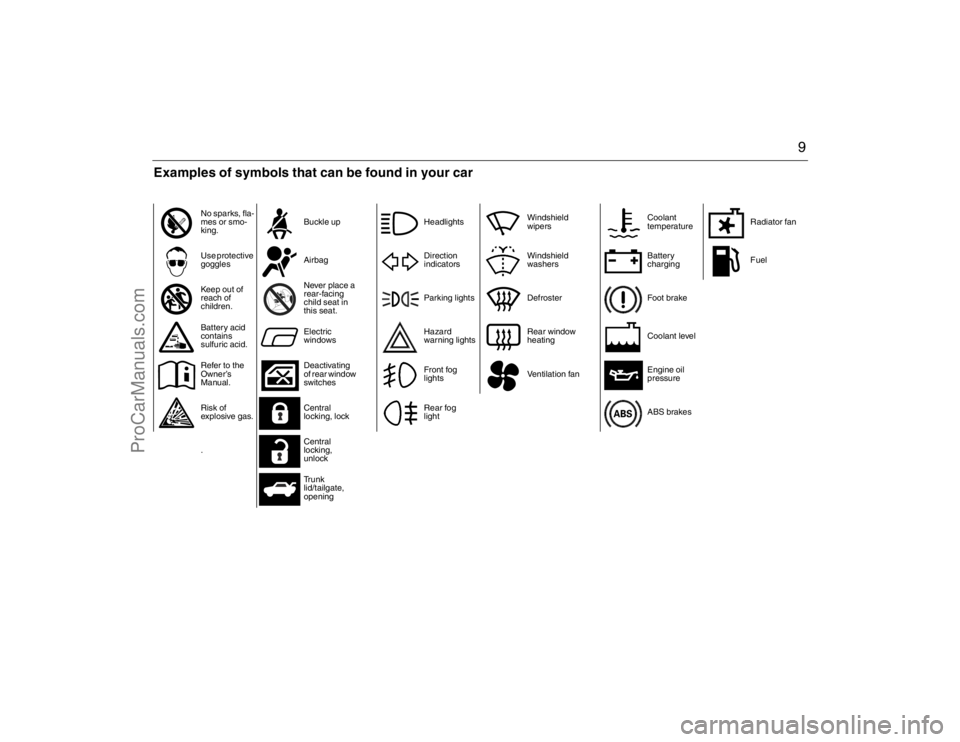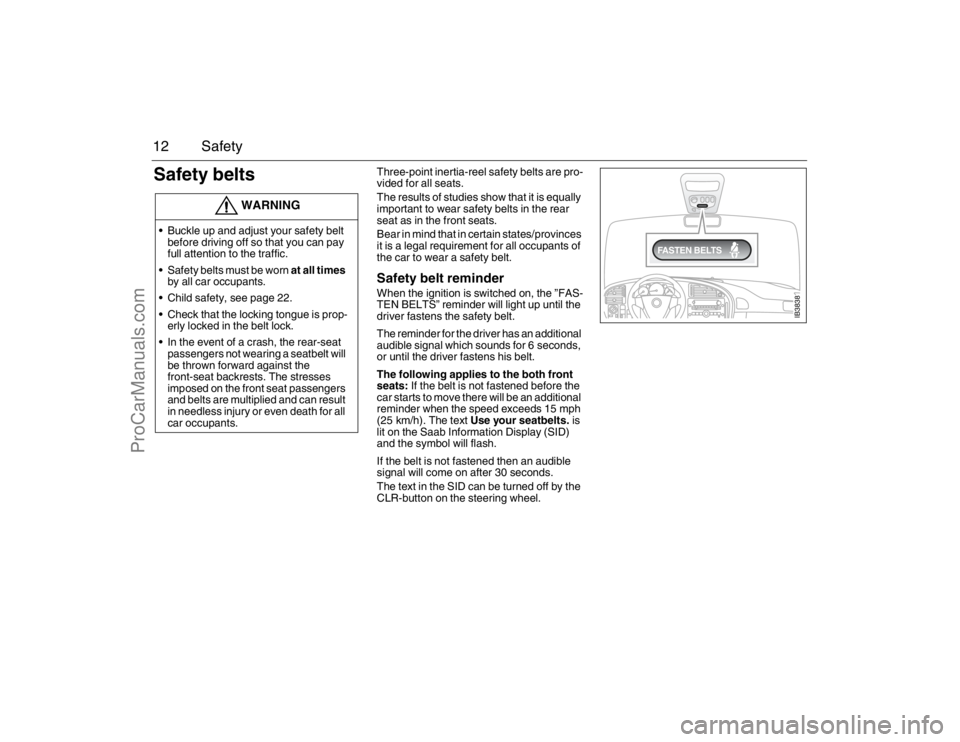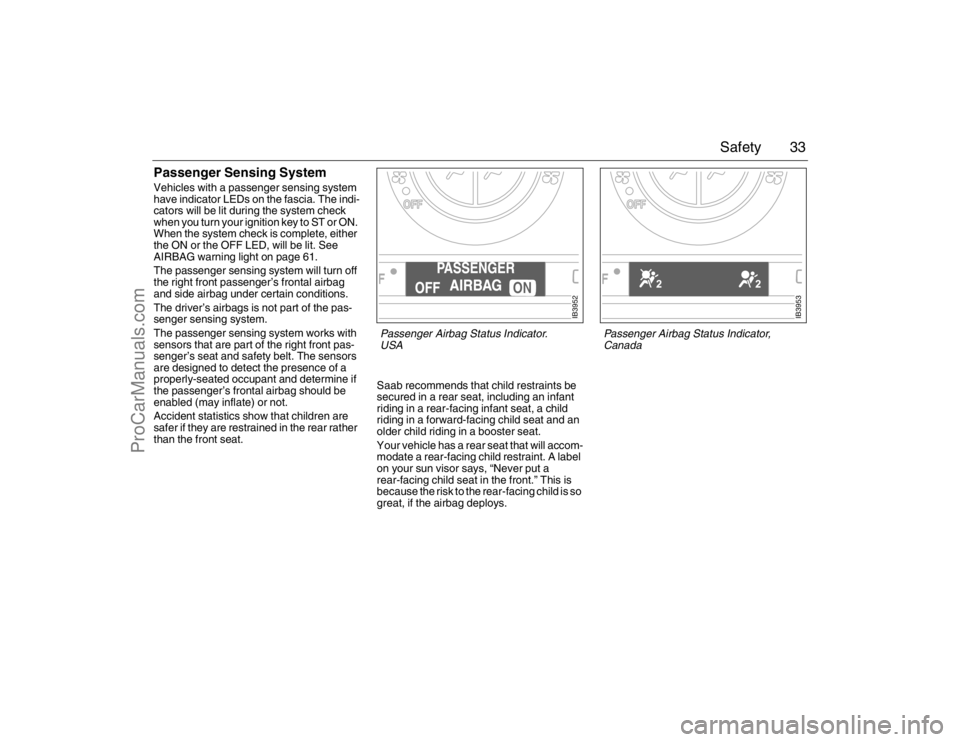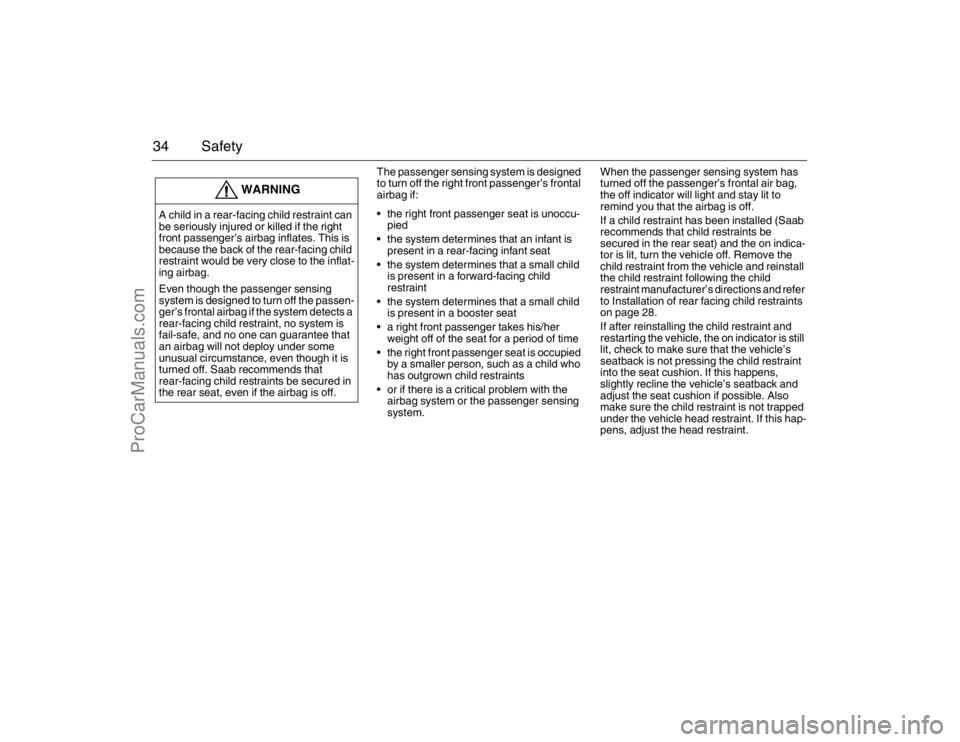warning light SAAB 9-5 2007 Owners Manual
[x] Cancel search | Manufacturer: SAAB, Model Year: 2007, Model line: 9-5, Model: SAAB 9-5 2007Pages: 288, PDF Size: 18.14 MB
Page 3 of 288

3
Instrument panel
IB3830
Indicator and warning lights ______ 58
Speedometer _________________ 65
Odometer and trip meter ________ 64
Fuel gauge___________________ 65
Temperature gauge ____________ 65
Saab Information Display (SID) ___ 68
Parking lights____________ 73
High/low beam __________ 73
Daytime running lights_____ 73
Instrument illumination ____ 75
Changing bulbs __________ 204
Rear fog light ____________ 74
NIGHT PANEL __________ 72Turn signal and lane change
indicators ______________ 75
High beam flasher ________ 73
Cruise control3_________ 159Front fog lights3_________ 76
NIGHT PANEL __________ 72
Powe r O ut l et3________________ 126
Wipers and washers ______ 77
Rear-window wiper
(SportCombi)3_________ 78
Rain sensing wipers3____ 77
Washers _______________ 203
Wipers and washers ______ 202Saab 9-5 Audio System3_ 90
Steering wheel controls3_ 91Hazard warning lights_____ 76Automatic climate control
(ACC) ________________ 79
Air conditioning (ACC) ____ 243
Heated front seats3___________ 87
Head restraint ________________ 21
Steering wheel controls3_______ 91
Sentronic, manual mode 33____ 15695_U S _M 07.book Page 3 Friday, June 9, 2006 8:58 AM
ProCarManuals.com
Page 8 of 288

8
IB336
WARNING
EVEN WITH ADVANCED AIR BAGS
Children can be killed or seriously
injured by the air bag.
The back seat is the safest place for
children.
Never put a rear-facing child seat in
the front.
Always use seat belts and child
restraints.Contact a Saab dealer if a
xenon headlight requires
replacement.
This label is only found on
cars with xenon head-
lights.
Jack
Use only on specified vehicles. Safe working load 1100
kg. Use on level firm ground only. Do not get under a
vehicle that is supported only by a jack, use vehicle sup-
port stands.
For more information see your owner´s manual.
95_U S _M 07.book Page 8 Friday, June 9, 2006 8:58 AM
ProCarManuals.com
Page 9 of 288

9
No sparks, fla-
mes or smo-
king.Buckle up
Use protective
gogglesAirbag
Keep out of
reach of
children.Never place a
rear-facing
child seat in
this seat.
Battery acid
contains
sulfuric acid.Electric
windows
Refer to the
Owner’s
Manual.Deactivating
of rear window
switches
Risk of
explosive gas.Central
locking, lock
.Central
locking,
unlock
Tr u n k
lid/tailgate,
opening
HeadlightsWindshield
wipers
Direction
indicatorsWindshield
washers
Parking lights Defroster
Hazard
warning lightsRear window
heating
Front fog
lightsVentilation fan
Rear fog
light
Coolant
temperatureRadiator fan
Battery
chargingFuel
Foot brake
Coolant level
Engine oil
pressure
ABS brakes
Examples of symbols that can be found in your car95_U S _M 07.book Page 9 Friday, June 9, 2006 8:58 AM
ProCarManuals.com
Page 12 of 288

12 SafetySafety belts
Three-point inertia-reel safety belts are pro-
vided for all seats.
The results of studies show that it is equally
important to wear safety belts in the rear
seat as in the front seats.
Bear in mind that in certain states/provinces
it is a legal requirement for all occupants of
the car to wear a safety belt.Safety belt reminderWhen the ignition is switched on, the ”FAS-
TEN BELTS” reminder will light up until the
driver fastens the safety belt.
The reminder for the driver has an additional
audible signal which sounds for 6 seconds,
or until the driver fastens his belt.
The following applies to the both front
seats: If the belt is not fastened before the
car starts to move there will be an additional
reminder when the speed exceeds 15 mph
(25 km/h). The text Use your seatbelts. is
lit on the Saab Information Display (SID)
and the symbol will flash.
If the belt is not fastened then an audible
signal will come on after 30 seconds.
The text in the SID can be turned off by the
CLR-button on the steering wheel.
WARNING
Buckle up and adjust your safety belt
before driving off so that you can pay
full attention to the traffic.
Safety belts must be worn at all times
by all car occupants.
Child safety, see page 22.
Check that the locking tongue is prop-
erly locked in the belt lock.
In the event of a crash, the rear-seat
passengers not wearing a seatbelt will
be thrown forward against the
front-seat backrests. The stresses
imposed on the front seat passengers
and belts are multiplied and can result
in needless injury or even death for all
car occupants.
FASTEN BELTS
IB3838
95_U S _M 07.book Page 12 Friday, June 9, 2006 8:58 AM
ProCarManuals.com
Page 25 of 288

25 Safety
Securing a Child Restraint
Designed for the LATCH System9-5 SportCombi:
Before installation, please read through
these instructions and the child restraint
installation instructions.
1 The top tether anchor is located on the
cargo floor by the rear seat backrest's
lower part (see picture). To access the
top tether anchor, unlock the rear seat
backrest (see page 132 for detailed
instructions), and fold it slightly forward.
Note! Backrest only, not the seat cush-
ion.
2 The top tether anchor is originally
rotated downwards. To use it, it has to
be rotated upwards (see arrow in pic-
ture). Use the top tether anchor right
behind the seating position you want to
use.
3 Raise the vehicle head restraint to its
highest position (see page 21 for
detailed instructions).
4 Put the child restraint on the seat.
5 If you are using a single tether, route the
tether under the vehicle head restraint,
and attach the tether hook to the top
tether anchor. If you are using a dual
tether, route the tether around the vehi-
cle head restraint, and attach the tether hook to the top tether anchor. The child
restraint instructions will show you
how.
6 Reposition the rear seat backrest, and
make sure it locks properly. Check the
indicator on top of the backrest that it is
locked.
7 Find the lower anchors for the seating
position you want to use. The lower
anchors are located where the bottom of
the seatback meets the back of the seat
cushion. Above each lower anchor,
there is a label indicating its location
(see picture on page 24).
8 Attach and tighten the lower anchor
attachments on the child restraint to the
vehicle lower anchors. If your child
restraint does not have the lower attach-
ments, you will be using the lap-shoul-
der belt to secure the child restraint. The
child restraint instructions will show
you how.
9 Tighten the top tether strap according to
the child restraint instructions.
10 Push and pull the child restraint in differ-
ent directions to be sure it is secured at
the lower anchors/safety belt and the top
tether anchor. The child restraint shall
be firmly attached to the vehicle.
WARNING
Make sure the child restraint anchorages
are folded all the way up or down other-
wise it can obstruct locking the rear seat
backrest.
WARNING
If a cargo net is fitted, do not pull the top
tether strap through the cargo net in such
a way that there is slack in the strap to the
child seat.
IB4113
Child tether anchorages, Saab 9-5 Sport-
Combi
95_U S _M 07.book Page 25 Friday, June 9, 2006 8:58 AM
ProCarManuals.com
Page 29 of 288

29 Safety
Airbag The AIRBAG system comprises an airbag in
the steering wheel, a front passenger airbag
and side airbags in the front seats.
The system supplements the protection
provided by the safety belts to further
enhance the safety of the occupants.
If a fault is detected in the AIRBAG, the
AIR BAG warning light on the main instru-
ment panel will come on (see pages 61
and 37). When the system is triggered by impact of a
frontal crash, the airbags in the steering
wheel and passenger side of the dash board
are inflated, after which they deflate through
vents in the back of the bags.
The entire process takes less than
0.1 second – literally, faster than the blink-
ing of an eye.
The driver and passenger airbags are
referred to as ‘smart’ airbags. This means
that the system compensates for factors
such as the force of the collision.Note:
The sensor reacts differently depending on
whether or not the front seatbelts on the
driver’s and passenger sides are used. Sit-
uations can therefore arise where only one
of the airbags inflates.
It is also possible for only the seatbelt pre-
tensioners to be activated and for the air-
bags to remain uninflated.
These airbags are triggered only by moder-
ate to severe frontal or near-frontal crashes.
They will not be activated by minor front-end
impacts, rear-end or side impacts, or by the
car rolling over.
WARNING
To reduce risk of injury:
Always wear your safety belt.
Always adjust your seat so that you
are as far back as possible but still
able to operate the pedals and reach
the steering wheel and controls com-
fortably.
Children 12 and under or shorter than
59 inches (150 cm) should always
travel in the rear seat as the car is fitted
with a passenger airbag.
Never fit a child seat in front of the pas-
senger airbag.
IB419
Inflated airbag (driver side) Inflation and deflation together take less than
0.1 second.
95_U S _M 07.book Page 29 Friday, June 9, 2006 8:58 AM
ProCarManuals.com
Page 30 of 288

30 Safety
WARNING
Even if the car is equipped with AIR-
BAG, safety belts must still always be
worn by all occupants.
Note that because an airbag inflates
and deflates extremely rapidly, it will
not provide protection against a
second impact occurring in the same
incident. Always use your safety belt.
Always sit with the whole of your back
in contact with the backrest of the seat,
and with your seat as far back as is
practical. Otherwise you will be thrown
back against the backrest when the
airbag inflates which could cause you
injury or death. The airbag needs
room in which to inflate.
Never attach anything to the steering
wheel or passenger side of the instru-
ment panel, as this could result in
injury if the airbag should inflate. The
same applies to anything you might
have in your mouth, such as a pipe, for
instance.
Some components of the airbag will
be warm for a short time. In some cir-
cumstances the airbag can cause
minor burns or abrasions to the body
when the airbag inflates/deflates.
To reduce the risk of head injuries in
the event of a crash, the headliner and
pillar trims incorporate energy absorb-
ing material. These areas must not be
modified in any way. Work on these
areas must only be carried out by an
authorized Saab dealer.
Fumes are generated by the chemical
reaction that inflates the airbag.
Because the dust/fumes can, in cer-
tain cases, cause irritation to the skin,
the following measures should be
taken:
Skin surfaces that show signs of irrita-
tion should be washed with clean
water and a mild soap as soon as pos-
sible.
In the event of eye irritation, flush the
eyes thoroughly with clean water for at
least 20 minutes.
In case of persistent irritation, consult
a doctor.
Never rest your hands or forearms on
the steering-wheel center padding.
If the AIR BAG warning light does not
extinguish after the car has been
started, or comes on or flashes while
driving, have the car checked immedi-
ately by a workshop. We recommend
that you contact an authorized Saab
dealer. The warning light could signify
that the airbags may not inflate in a
crash, or they could even inflate with-
out a crash. See page 61.
IB420
Passenger airbag and driver’s airbag both
inflated 95_U S _M 07.book Page 30 Friday, June 9, 2006 8:58 AM
ProCarManuals.com
Page 32 of 288

32 SafetyFront passenger seat The airbags are interconnected and have a
common warning light. The passenger
airbag module is housed in the fascia above
the glove compartment and is marked
AIRBAG
Both airbags will be inflated in the event of a
moderate to severe frontal, or near-frontal
crash, even if the passenger seat is unoccu-
pied.
WARNING
Never secure a rear-facing child seat in
the right front seat of a car equipped with
a passenger airbag. Inflation of the airbag
in the event of a crash could seriously
injure or kill a child.
WARNING
DEATH or SERIOUS
INJURY can occur.
Children 12 and under or
shorter than 59 inches
(150 cm) can be killed by
the airbag.
The BACK SEAT is the SAFEST place
for children.
NEVER put a rear-facing child seat in
the front.
Sit as far back as possible from the air-
bag.
ALWAYS use SAFETY BELTS and
CHILD RESTRAINTS.
Never allow a child to stand in front of
the seat or to sit on the lap of a
front-seat passenger. Serious injury or
death could result if the airbag is
inflated in a crash.
The glove compartment must be
closed while travelling. An open glove
compartment door could cause leg
injuries in the event of a crash.
Never place anything on the dash or in
front of the seat as, in addition to being
a hazard to passengers, this could
interfere with the function of the airbag
in the event of a crash. The same
applies to the mounting of accessories
on the dash.
Keep feet on the floor – never put feet
up on the fascia, on the seat or out of
the window.
Do not carry anything in your lap.
95_U S _M 07.book Page 32 Friday, June 9, 2006 8:58 AM
ProCarManuals.com
Page 33 of 288

33 Safety
Passenger Sensing SystemVehicles with a passenger sensing system
have indicator LEDs on the fascia. The indi-
cators will be lit during the system check
when you turn your ignition key to ST or ON.
When the system check is complete, either
the ON or the OFF LED, will be lit. See
AIRBAG warning light on page 61.
The passenger sensing system will turn off
the right front passenger’s frontal airbag
and side airbag under certain conditions.
The driver’s airbags is not part of the pas-
senger sensing system.
The passenger sensing system works with
sensors that are part of the right front pas-
senger’s seat and safety belt. The sensors
are designed to detect the presence of a
properly-seated occupant and determine if
the passenger’s frontal airbag should be
enabled (may inflate) or not.
Accident statistics show that children are
safer if they are restrained in the rear rather
than the front seat.Saab recommends that child restraints be
secured in a rear seat, including an infant
riding in a rear-facing infant seat, a child
riding in a forward-facing child seat and an
older child riding in a booster seat.
Your vehicle has a rear seat that will accom-
modate a rear-facing child restraint. A label
on your sun visor says, “Never put a
rear-facing child seat in the front.” This is
because the risk to the rear-facing child is so
great, if the airbag deploys.
IB3952
Passenger Airbag Status Indicator.
USA
IB3953
Passenger Airbag Status Indicator,
Canada
95_U S _M 07.book Page 33 Friday, June 9, 2006 8:58 AM
ProCarManuals.com
Page 34 of 288

34 Safety
The passenger sensing system is designed
to turn off the right front passenger’s frontal
airbag if:
the right front passenger seat is unoccu-
pied
the system determines that an infant is
present in a rear-facing infant seat
the system determines that a small child
is present in a forward-facing child
restraint
the system determines that a small child
is present in a booster seat
a right front passenger takes his/her
weight off of the seat for a period of time
the right front passenger seat is occupied
by a smaller person, such as a child who
has outgrown child restraints
or if there is a critical problem with the
airbag system or the passenger sensing
system.When the passenger sensing system has
turned off the passenger’s frontal air bag,
the off indicator will light and stay lit to
remind you that the airbag is off.
If a child restraint has been installed (Saab
recommends that child restraints be
secured in the rear seat) and the on indica-
tor is lit, turn the vehicle off. Remove the
child restraint from the vehicle and reinstall
the child restraint following the child
restraint manufacturer’s directions and refer
to Installation of rear facing child restraints
on page 28.
If after reinstalling the child restraint and
restarting the vehicle, the on indicator is still
lit, check to make sure that the vehicle’s
seatback is not pressing the child restraint
into the seat cushion. If this happens,
slightly recline the vehicle’s seatback and
adjust the seat cushion if possible. Also
make sure the child restraint is not trapped
under the vehicle head restraint. If this hap-
pens, adjust the head restraint.
WARNING
A child in a rear-facing child restraint can
be seriously injured or killed if the right
front passenger’s airbag inflates. This is
because the back of the rear-facing child
restraint would be very close to the inflat-
ing airbag.
Even though the passenger sensing
system is designed to turn off the passen-
ger’s frontal airbag if the system detects a
rear-facing child restraint, no system is
fail-safe, and no one can guarantee that
an airbag will not deploy under some
unusual circumstance, even though it is
turned off. Saab recommends that
rear-facing child restraints be secured in
the rear seat, even if the airbag is off.95_U S _M 07.book Page 34 Friday, June 9, 2006 8:58 AM
ProCarManuals.com